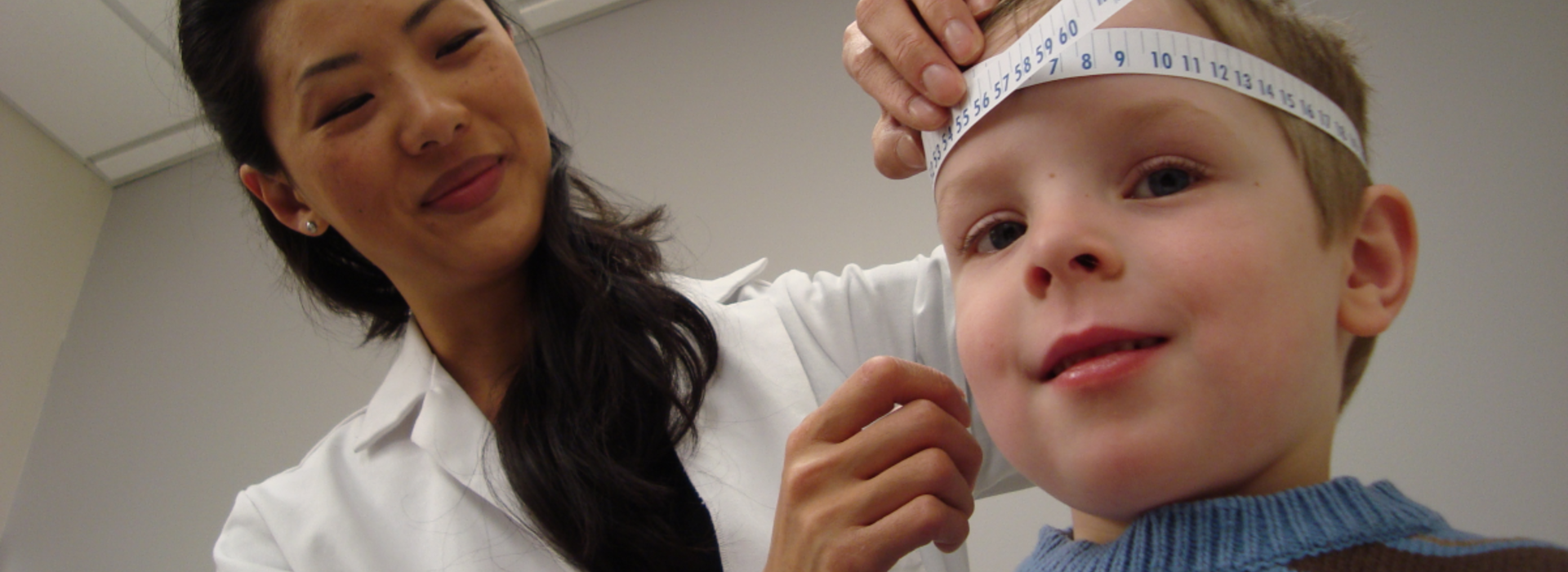
How to Measure Head Growth
Method
- The measurement should be taken with a device that cannot be stretched, such as a flexible metal tape measure.
- Wrap the tape snugly around the widest possible circumference - from the most prominent part of the forehead (often 1-2 fingers above the eyebrow) around to the widest part of the back of the head.
- Try to find the widest way around the head.
- Remeasure 3 times, and take the largest number.
Head Growth in Adoption Medicine
The dilemma we face in adoption medicine is that we are not only tasked with determining the health status of a child, but are asked to judge whether a child's brain is healthy. We are requested to assist the family in choosing a child who has a good chance of being a happy and productive member of society, able to participate fully in life's joys and opportunities.
Common Issues
It is impossible to inadvertently inflate the OFC unless a stretchable measuring device is used but easy to obtain a measurement that is artifactually small if one does not move the tape around to seek the largest measurement. This is probably the most common reason why a child has a "small" head circumference.
Remeasuring the head around the biggest possible circumference may place the child within the normal range.
In rare situations, such as premature closure (ossification) of the junctions (sutures) between specific skull bones, brain growth causes the skull to expand upward rather than from front to back. Children with this condition, termed craniosynostosis, may have a small measured OFC but a brain of normal size.
How Important are Head Measurements in Determining a Child's Health
Head growth has been used by generations of healthcare providers as a marker of brain well-being. Plotting head growth is a ritual in the offices of child healthcare providers worldwide, and children whose heads measure too small or too large for their age are viewed with great concern. However, problems may be encountered with obtaining and interpreting this measurement. These problems are magnified when the child's head is being measured by another individual and interpreted in the absence of complete medical and social information about the mother and child. Nevertheless, head circumference is one of the few pieces of objective information usually included in the referral document.
Does Head Circumference Really Measure Brain Growth?
In infants between 18 and 43 weeks gestation who died during the first week of life, brain weight correlated directly with head circumference using log10 transformations of the measuremnts. Postnatally, total brain DNA content (number of cells) is linearly directly related to changes in head circumference during the first six months of life, and brain weight and protein content are proportionate to cranial volume calculated from the OFC through the first year of life. For brain growth and head circumference beyond the first year of life, the relative rates of growth are fairly similar. Nearly all brain growth occurs in the first two years and virtually ceases by four years of age. Therefore, head circumference accurately reflects brain size and growth during gestation and the first years of life, the period with the majority of brain growth, except in unusual situations such as hydrocephalus, enlargement of the subdural space, significant scalp edema or a rickets-thickened skull.
Does Head Size Correlate with Neurologic Outcome?
A correlation between small head circumference (microcephaly) and mental retardation has been recognized since the pioneering work of Kind in 1876 and Tarbell in 1883. This relationship was established primarily through studies that documented a high incidence of microcephaly in groups of mentally retarded or neurologically at-risk individuals. For example, in 1960, measurements were recorded for 2,472 inmates of the California State Institution for the Mentally Deficient. Head circumference means for the total group were below normal for virtually the entire age range. Another study reviewed the clinical records of 247 children from 1 to 15 years of age with small head size, dwarfism, mental retardation, microcephaly or developmental retardation seen between 1956 and 1961 at the Mayo Clinic. The authors concluded that children with a head circumference below minus 2 standard deviations from the mean are, probably with few exceptions, mentally subnormal.